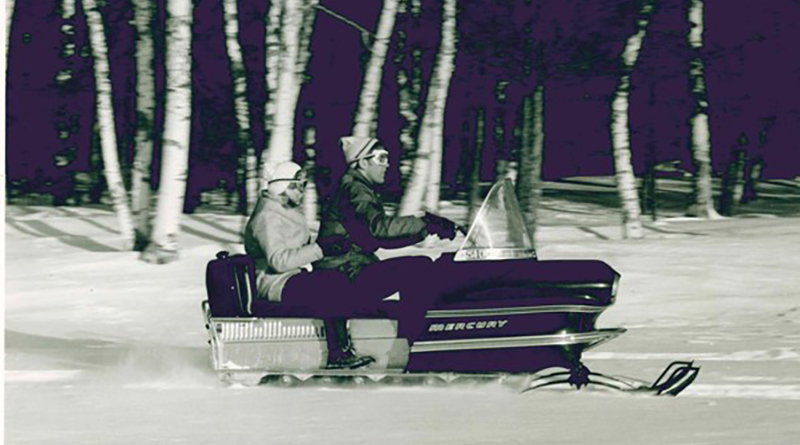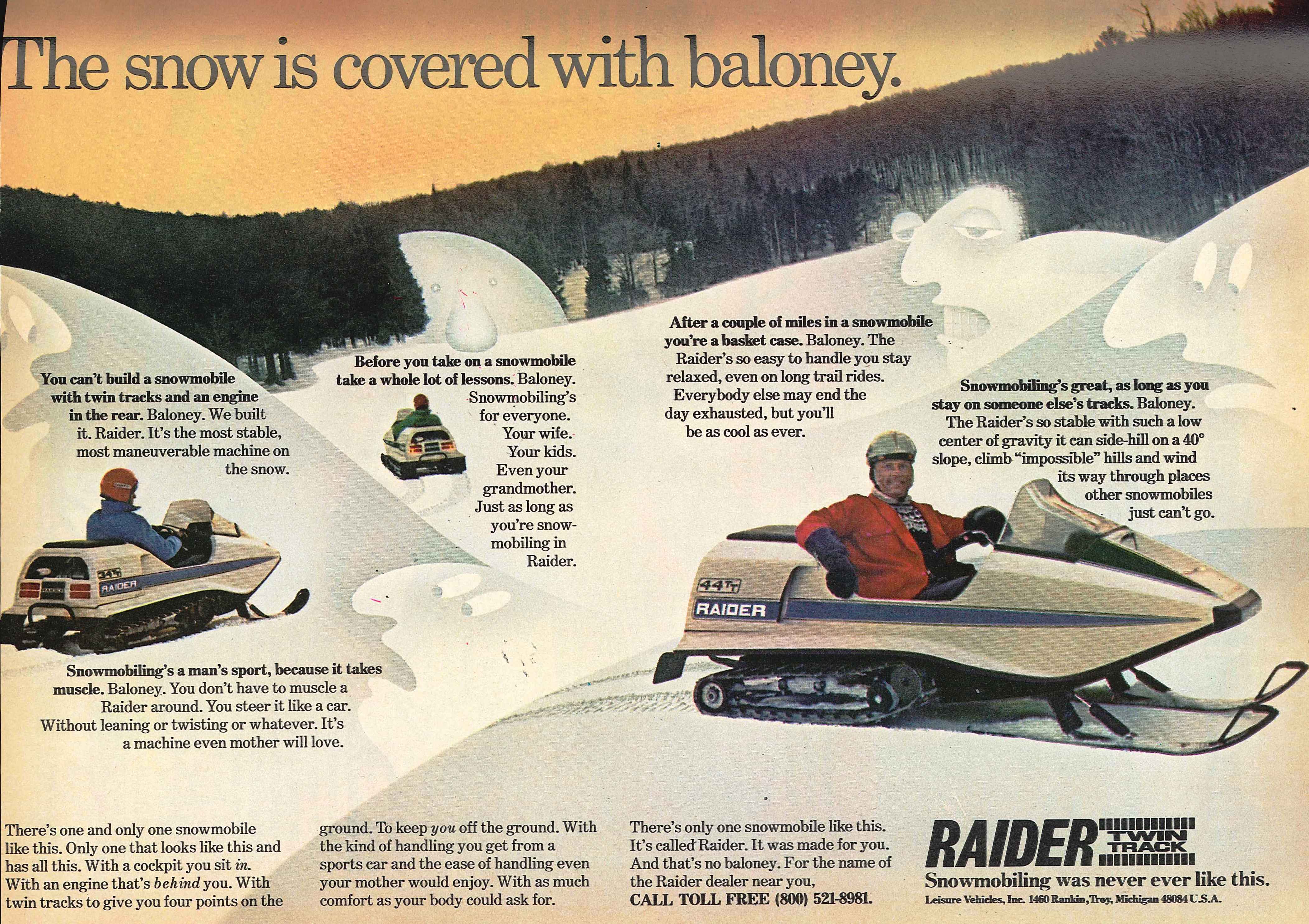On February 7, 1976, a team led by Stan and Doug Hayes earned a historic victory in the Soo I-500 aboard a Mercury Sno-Twister-based machine. The joy of the victory was short lived, however, as just four days later (February 11) Mercury announced it was getting out of the snowmobile manufacturing business.
What follows is a story written for the Feb. 7, 1976, cover date issue of Snow Week magazine by the late C.J. Ramstad. The very next issue of Snow Week carried the cover line: “MERC ANNOUNCES Drops Snowmobile Line”. Sorry about the picture quality — we don’t have the originals anymore; what you’re seeing is scans out of the newsprint magazine.
Let us know if you’d like to see more Snow Week flashback articles.
– Editor
1976 Sault Ste. Marie I-500
Stan Wins The Granddaddy … Again
A few years back, a fellow name of Yarhouse was standing along the fence at the I-500 with some friends when he was heard to make the statement that an Arctic Cat would win this biggest of the enduros. Dave Yarhouse is apparently a man who is willing to put his words into action as he has raced the enduros (on Arctic Cat) and won. He won the Alpena 250 earlier in this Triple Crown series and finished second behind Randy DeWitt in the Traverse City 250 when bad luck in the form of a blown clutch snatched away the victory scant laps before the finish.
But winning is a hard thing to keep up and, in this eighth running of the Soo 500 on February 7 [1976], Dave had the odds going against him. His 650 was blown and he was forced to run an untested 440 engine in his tired Cat. Other factors standing in the way of a third high finish included a start position back in the middle of the pack for this non-stop 500 miler. Ahead of him were Gene Denman on the pole, a 4-time finisher; Buddy Weber, last year’s winner in the No. 2 position; Randy DeWitt, running second in Triple Crown points and third at the starting line. Besides DeWitt, Yarhouse faced a threat from George Pattullo, an 8-year veteran of the race who, if he were to win, would pass Yarhouse in points. Dana Wiltse, who won the TC250 after Yarhouse broke down, could also nab the Triple Crown’s $1,000 pay-off with a victory here. He was starting 14th, well within striking range.
Starting 13th on that cold, overcast morning was Stan Hayes of the Mercury Racing Team. 13 is a lucky number in the I-500 and Triple Crown competition with several victories being tallied by riders starting in the 13th position. But Stan and crew had more going for them than superstition.
In 1971, Stan turned up at the I-500 with a Ski-Doo and Ed Schubitzke. Qualifying 11th that year, Stan and Ed rode to a second place in their first shot at the almost 11-hour enduro. Stan came back with brother Doug Hayes in 1973 to serve as back-up riders for Polaris’ LaVern Hagen. Hagen and the Hayes brothers split the driving and the team won the race while setting an elapsed time record for the I-500 that still stands [as of the writing of this original article in 1976]. This year, the team from Fond du Lac consisted of Stan, Doug and ace Merc wrench James Witt.
The start of this spectacular enduro is something that must be seen to be fully appreciated. When the green flag is given, the 50 qualifiers thunder around the 1-mile oval in a tight pack kicking up snow dust that makes visibility the major determiner of average speed in the early running. This year the start was shifted to the first turn to avoid the high-speed charge down the front straight that has resulted in first lap crack-ups in the past. This start went without mishap.
In a long distance race, the typical speeds and driving techniques of sprint racing are mostly absent. Buddy Weber is from the Soo and was naturally a crowd favorite to repeat his feat of a year ago. His position next to the pole allowed him to cruise along in position while things got sorted out behind him. Hayes is a sprint driver most weekends and he moved easily into 3rd position before lap 30. As Stan took ever 3rd, Dave Yarhouse’s Cat was running 7th. A few laps later he had dropped to 8th and, on lap 60 as Doug Hayes pushed Merc #13 into the lead, Yarhouse was sliding back fast.
Yarhouse was out on lap 64 as his tired, broken and “just wore out” sled became No. 4 in the official “boneyard.” Randy DeWitt had high finish points from both 250s and his position in 5th place made him the most likely to beat Yarhouse in the Triple Crown. If anybody could do it all, DeWitt could, with any finish above 6th.
The Hayes team held the lead for a bit over 30 laps before relinquishing it back to Weber and co-driver McDowell. After a long pit stop, Merc #13 came out with Jerry Witt in the saddle and one lap down. The Dave Stevenson and Grant Hawkins teams, both on Yamahas, made steady progress out of the middle of the pack to grab positions in the top 5 by lap 150. Joe Wolf’s Yamaha #6 held 3rd for most of the first 150 and was holding 5th when the race was one-third over. Yamahas accounted for 4 out of the top 5 for the next 150 miles as Wolf fell back and the Yammie ridden by Fred Downing moved in.
Snow began to fall steadily beginning on lap 200 (1:30 p.m.) as the race settled down to a regular order. The Hayes Merc held second place just a lap or two down almost until lap 300 as the Weber Yamaha sped around the ice mile passing slower drivers in every turn. In an enduro event of this kind, the lead is measured in laps rather than sled lengths and, at lap 301, over 20 laps separated the top 5.
As the weather conditions and track surface deteriorated in the later afternoon, the Hayes Mercury pulled slowly into the lead. Weber started having track and idler trouble and this kept the 2-driver team out of the lead, despite some very hard charging in the later laps.
By 6 p.m., darkness had fallen and the lights around the now chewed-up one-mile oval were burning brightly in a futile attempt to light the track through a thick, moist snowfall. Officials polled the drivers as they pitted and none said the race should stop. By this time the sticky snow was beginning to collect on goggles and face shields so the race officials huddled and announced that the race would end after lap 440.
True to their word, the race stopped after lap 440 on lap 441 when Stan saw first the white, then the checkered. Stan took the flag around the track for a victory lap and came back to the finish line with his co-drivers, Jerry and Doug. After 441 laps officially, the Hayes Merc #13 had won the 8th annual Soo in 7 hours, 54 minutes to collect the $6,000 grand prize and $960 in lap money for leading 192 laps. Their sled was a Trail Twister originally built up for the Winnipeg 500 cross-country. The team put a stock 440 Kohler/Merc motor in and replaced the muffler box with stingers on the stock pipes. If there was any single reason to point to why they won, it was the Hayes Bros. ability to set a rapid pace on the rough, mogul-filled track that existed during the final 150 miles. A second factor was a sled that required repairs only to the driven clutch in the entire 441 miles.
The next 3 sleds in line were all Yamaha SRXs. Capable of the fastest steady lap times of the day, the lead Yamahas were sensitive to track tension and, as the track conditions worsened, adjustments to idlers and suspensions became critical. Weber finished 2nd, 18 laps out of victory after two extended pit stops on the late running. The Downing team pushed up to 3rd, 22 laps down and Grand Hawkins tagged 4th, 37 laps down after riding in the top 4 most of the race.
The Soo is a long way from any population centers and few roads lead there. Yet, this event attracted the biggest crowd of any event of the season. On look at the 3-4 deep spectators lining the entire track and the giant viewing hill covered with fans, plus the acres of campers that begin arriving the Tuesday previous and you know the high count claimed by the Jaycees for this “baby” is based on fact. The Soo is an impressive and exciting snowmobile race held on a track built solely for that single Saturday ever winter that is well-planned, well-staffed and well-executed. The frosting on the case is the ability of the crew to keep everyone aware of what’s happening. Along with the P.A., radio and a huge lap counter system, the race utilizes a computer terminal that had results before the finishing sleds had been completely cleared off the track.
Dave Yarhouse won the Triple Crown prize anyway. What he said about a Cat winning is therefore proven truth. Now Dave can start planning his attack on this biggest enduro for 1977 and put a Cat in the record book. Thousands will be there to witness it again.
RESULTS:
- Stan Hayes, Mercury, 441 laps
- Buddy Weber, Yamaha, 432 laps
- Fred Downing, Yamaha, 418 laps
- Grant Hawkins, Yamaha, 403 laps
- Dennis Ellis, Arctic Cat, 399 laps
- Bill Christ, Rupp, 393 laps
- Pat Campbell, Ski-Doo, 385 laps
- Rhett Butler, Yamaha, 382 laps
- James Wholfeil, John Deere, 382 laps
- George Pattullo, Polaris, 376 laps



Great article! I didn’t get into vintage/antique sleds until the last few years. I really enjoyed reading CJ’s write up. Keep the Snow Week flashbacks comin!!